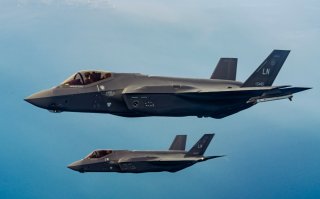Special Relationship: Is a Joint U.S.-UK Stealth Fighter in the Works?
The two countries are no strangers to aerospace cooperation, though recent signaling suggests an even tighter partnership is coming.
The United States and the United Kingdom worked closely on previous aerospace projects, perhaps the most famous of which is the F-35 stealth fighter. The fifth-generation aircraft—currently the world’s most widely-operated stealth aircraft—has been a rousing success.
Although the United Kingdom and the United States are both pursuing sixth-generation aircraft, their efforts have been separate. “We’re aware the U.K. is working with Sweden and Italy on [Tempest],” the United States Air attaché in London, United States Air Force Col. Charles E. Metrolis said in an interview with Air Force Magazine. “And I saw the announcement about involving Japan, though I believe the U.K. will have to formally submit a request to Sweden and Italy to have Japan join the program.”
Still, it seems that both the United States and the United Kingdom could once again combine forces on fighter development and gain the best of what each sixth-generation program has to offer.
“We would welcome the U.K.’s thoughts on sixth-gen development and deployment. But it’s not clear right now how that will look,” Colonel Metrolis said. “It’s going to be the latest technology on both sides… So if they have a particular insight or capability they can share, or we have something we can share with them, that’s good for the alliance,” Colonel Metrolis added. “Basically, it’s best practices. There will be some avenue for crosstalk in the future in terms of development.”
The United States and the United Kingdom are no strangers to cooperating with each other either. Last year’s AUKUS agreement brought Australia into a nuclear submarine pact with Washington and London, widely considered the crown jewels of both countries’ nuclear deterrents. Australia could also be brought into sixth-generation fighter programs as well. “There’s so much more that’s being thought about,” Colonel Metrolis noted, “especially in air and space: the E-7, fifth- and sixth-gen fighters. Sixth-generation might become an AUKUS pillar.”
Including Australia in the sixth-generation fighter program would also increase interoperability with a key ally in the Indo-Pacific region. Given that tensions with China are at an all-time high, building a robust and organic Australian capability would serve American, British, and Australian interests.
“We’re very interoperable with the U.K., more than any other nation,” Colonel Metrolis said. “And as the F-35 rolls out across NATO, along with other platforms like the E-7, we’ll become even more interoperable. But we still have a lot to do with the interoperable piece.”
Caleb Larson is a multimedia journalist and defense writer with the National Interest. A graduate of UCLA, he also holds a Master of Public Policy and lives in Berlin. He covers the intersection of conflict, security, and technology, focusing on American foreign policy, European security, and German society for both print and radio. Follow him on Twitter @calebmlarson.
Image: DVIDS.

